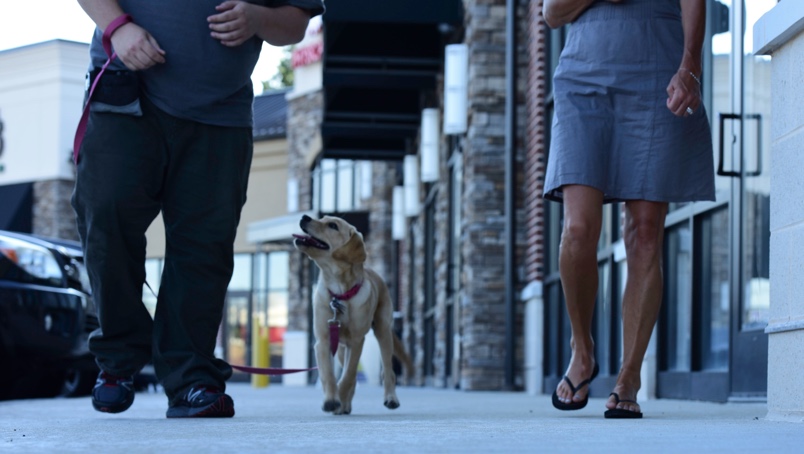How To Train Your Pup For Life On The Go
The most important thing to remember in training your pup is “practice, practice, practice.” It’s a process, and it may take a while, but with enough practice your pup will learn and be ready to go anywhere with you.
On the 26th of April, Puppy Mama interviewed Dave Shade, the founder of At Attention Dog Training. Dave served as a paratrooper for 15 months in Afghanistan, receiving a Purple Heart for his service. He left the army in 2009 and struggled to transition back into civilian society. Soon, he met his dog Lulu and found her healing presence helped him cope with his PTSD.
Dave started At Attention Dog Training in 2015 in the Philadelphia area to teach people learn to build better bonds with their dogs, help the dogs to be better family members, and give dogs and pet parents the ability to go more places together. At Attention helps with puppy and obedience training, as well as socialization, manners, and control. They strive to give both owners and dogs the skills needed to make the human-dog relationship work. Their methodology is force-free, fear-free, and pain-free.

Dave shared insights into the biggest problems in taking dogs new places and how to overcome them. He shares, “If we put our dogs into these scenarios where they’re not comfortable and they start feeling fear, anxiety and stress, that’s going to be where you see the symptomatic behavioral problems.” The best way to deal with this is through socializing your puppy to be comfortable with the situations and places they will likely be exposed to early on in their life. It's important to not just expose them to those situations, you must create positive experiences in those situations. That way, your pup isn't just used to those situations, they have positive associations with them. This isn't always possible, of course.
Sometimes dogs aren't brought into the family until later in their life, sometimes they simply weren't well socialized when they were younger. In that case, remedial socialization becomes the main solution. During this process, it's important to stay patient and keep the mantra of "practice, practice, practice" in mind. After figuring out the type of situations you will be taking your pup to and want them to be comfortable in, bring them into those scenarios and create positive associations to that environment. “Maybe you bring your puppy’s favorite treats along and give them some treats while they’re experiencing that environment or if they have a favorite toy, maybe bring the toy along then kind of give them a little play session throughout the time that they’re in the environment.”
Starting small is important here. If it's a relatively unchallenging scenario, simply bringing your dog into that scenario, making it a positive experience, then leaving after a short time is a good way to start. Slowly ramping up the time spent there -- all while creating those positive associations -- should eventually get them comfortable enough to be happy when you bring them along on normal outings.

For a bigger challenge, you can recreate smaller aspects of those environments and slowly add in more as they get used to it. For example, if you wanted to bring your dog (20 pounds or less) on a long flight with you, it would be good to have them go into the travel crate at home with some food to get used to it. After they're comfortable with that, moving on to putting them beneath your feet for car rides (starting with small trips then ramping up the time incrementally). Eventually they should be comfortable enough staying in the crate in airplane-like conditions that they won't cause exhibit behavioral problems on the flight.
This is important for the comfort of pet parents, dogs, and the surrounding people in the relevant situations. Furthermore, just as it's helpful to get dogs used to new scenarios by creating positive associations with them, it's helpful to get people used to dogs being around in public by creating positive associations. The more people see well-behaved dogs in public and have their day brightened by their presence, the more people will be amenable to dogs being accepted in more public places.

“Train the dogs, make sure they’re comfortable and stress-free in those environments and they should do really, really well. And then the cultural belief will shift where, hey, it’s okay if dogs come to the café and sit outside. That’s not a problem.”
- written by Jill Zimmerman
